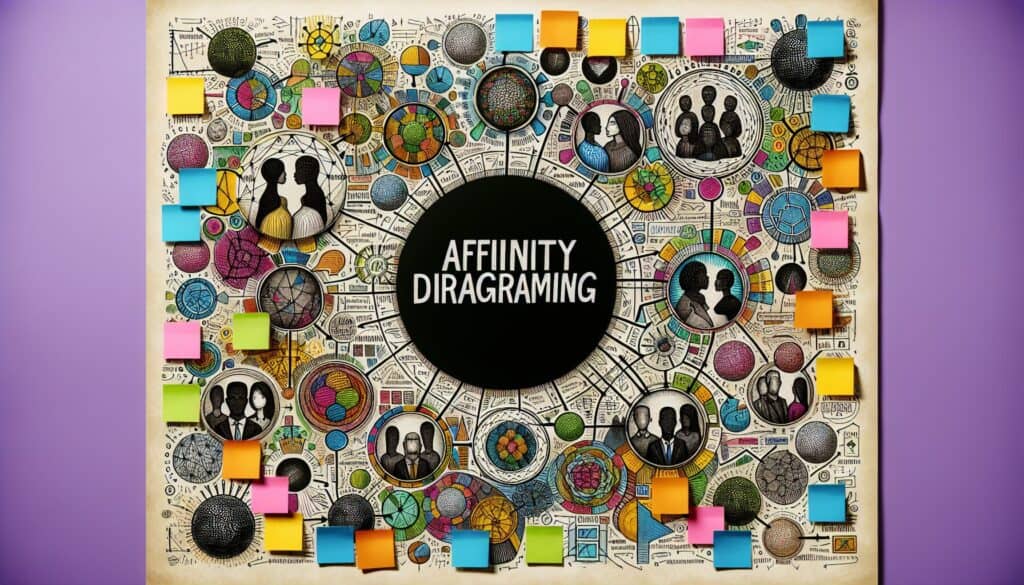A technique used to organize a large number of ideas, issues, or pieces of information into related groups or themes based on their natural relationships. Also known as the KJ Method.
- Méthodologies : Ingénierie, Qualité
Diagramme des affinités (méthode KJ)

Diagramme des affinités (méthode KJ)
- Remue-méninges, Gestion du changement, Amélioration continue, Pensée conceptuelle, Idéation, Innovation, Techniques de résolution de problèmes, Gestion de la qualité, User-Centered Design
Objectif :
Comment il est utilisé :
- Ideas (often written on sticky notes) are generated by a group. Participants then silently group related ideas together. Once grouped, the team discusses the groupings and creates header cards or labels that capture the essence of each theme.
Avantages
- Helps to make sense of large amounts of qualitative data or brainstormed ideas; Encourages participation and builds consensus; Reveals underlying themes and patterns; Relatively simple and quick to implement.
Inconvénients
- Can be time-consuming with very large datasets; Grouping can be subjective and influenced by dominant personalities if not well-facilitated; The resulting themes may require further analysis or prioritization.
Catégories :
- Clients et marketing, Idéation, Résolution de problèmes, Conception de Produits, Qualité
Idéal pour :
- Organizing and synthesizing large amounts of qualitative data, such as brainstormed ideas, user feedback, or research notes, to identify key themes and insights.
Affinity Diagramming, also known as the KJ Method, serves as a powerful tool in diverse sectors such as product development, user experience research, and strategic planning, particularly during the ideation and concept development phases of projects. This methodology is often initiated by cross-functional teams, including designers, engineers, product managers, and market researchers, who come together to gather qualitative data, which can encompass user feedback, insights from customer interviews, or brainstorming sessions. As team members silently sort ideas written on sticky notes, this organization encourages individual reflection while promoting engagement among participants, leading to a more thorough consideration of various perspectives. After the grouping process, the discussion phase allows teams to collaboratively label these clusters, which supports consensus building around key themes that may influence subsequent design choices or strategic directions. Affinity Diagramming is frequently utilized in industries such as technology, healthcare, and consumer goods, where understanding user needs and preferences is imperative to create effective solutions. Practitioners appreciate its simplicity and speed, as it can be completed within a few hours, making it adaptable for rapidly evolving project timelines while ensuring that team voices are heard equally in the development process. This method not only organizes ideas but also reveals patterns that might otherwise go unnoticed, providing a structured framework for driving innovation and aligning team objectives with user-centric insights.
Principales étapes de cette méthodologie
- Generate ideas on sticky notes individually.
- Silently arrange related ideas into groups on a shared surface.
- Review groups and discuss relationships between ideas with the team.
- Create header cards or labels for each group that summarize the main theme.
- Refine groupings and headers based on team discussions.
- Identify and prioritize key themes for further exploration or action.
Conseils de pro
- Encourage participants to use diverse perspectives by inviting individuals from different departments or backgrounds to enhance the variety of ideas generated.
- Utilize color-coded sticky notes to represent different categories or themes, facilitating quicker visual identification during the grouping process.
- Incorporate a follow-up phase for synthesizing the grouped ideas into actionable strategies, ensuring that the themes lead to concrete outputs beyond the initial session.
Lire et comparer plusieurs méthodologies, nous recommandons le
> Référentiel méthodologique étendu <
ainsi que plus de 400 autres méthodologies.
Vos commentaires sur cette méthodologie ou des informations supplémentaires sont les bienvenus sur le site web de la Commission européenne. section des commentaires ci-dessous ↓ , ainsi que toute idée ou lien en rapport avec l'ingénierie.
Contexte historique
1949
1950
1950
1960
1960
1960
1960
1940
1950
1950
1958
1960
1960
1960
1960
(si la date est inconnue ou n'est pas pertinente, par exemple "mécanique des fluides", une estimation arrondie de son émergence notable est fournie)















Articles Similaires
Questionnaires sur les troubles musculo-squelettiques
Tests à plusieurs variables (MVT)
Analyse de régression multiple
Systèmes de capture de mouvement
Méthode MoSCoW
Test de la médiane de Mood